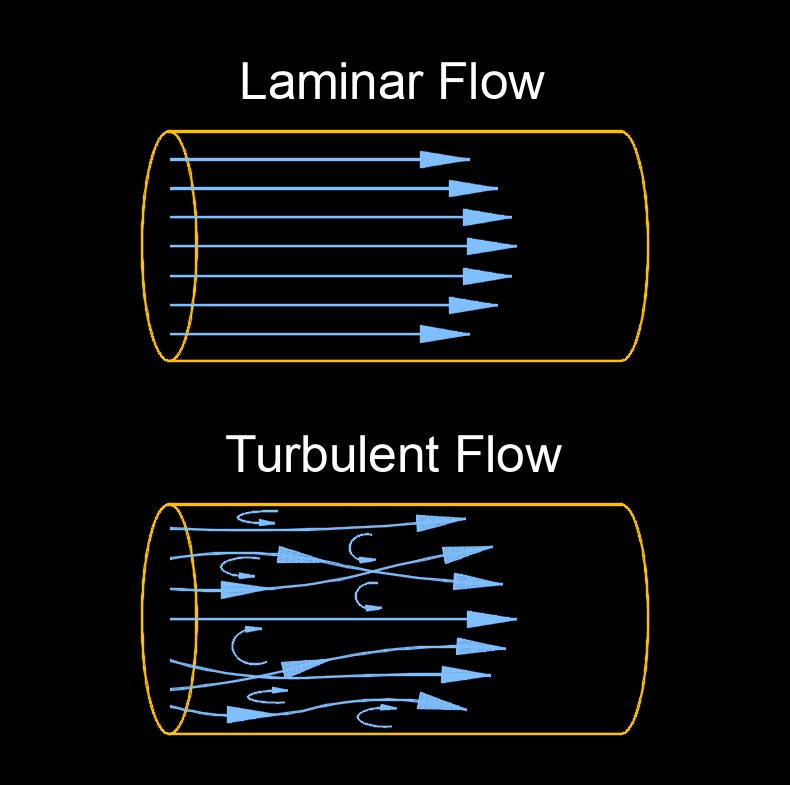 Turbulence flow is any deviation from parallel flow in a pipe due to rough inner walls obstructions or direction changes. It is the chaotic and irregular motion of a fluid (liquid or gas) characterized by rapid fluctuations in velocity, pressure, and other flow properties. It's a phenomenon that occurs when a fluid flows in a manner that is unpredictable, often resulting in swirling eddies, vortices, and rapid changes in flow direction and speed. Turbulence can be observed in various natural and man-made situations, such as rivers, oceans, air flows, and industrial processes.
Turbulence flow is any deviation from parallel flow in a pipe due to rough inner walls obstructions or direction changes. It is the chaotic and irregular motion of a fluid (liquid or gas) characterized by rapid fluctuations in velocity, pressure, and other flow properties. It's a phenomenon that occurs when a fluid flows in a manner that is unpredictable, often resulting in swirling eddies, vortices, and rapid changes in flow direction and speed. Turbulence can be observed in various natural and man-made situations, such as rivers, oceans, air flows, and industrial processes.
Key Points about Turbulent Flow
Randomness - Turbulent flow is highly disordered and exhibits random fluctuations in velocity and pressure. The fluid particles move in a seemingly chaotic manner, with no clear and organized patterns.
Eddies and Vortices - Turbulence is marked by the formation of eddies and vortices of varying sizes. These swirling structures contribute to the irregular and chaotic nature of the flow.
Mixing - Turbulence enhances the mixing of
fluid components. This is particularly important in applications such as chemical reactions,
heat transfer, and mass transfer, where efficient mixing is desirable.
Energy Dissipation - Turbulence involves the conversion of
kinetic energy into heat through the friction and collision of fluid particles. This energy dissipation is what causes the chaotic motion to eventually slow down and dampen.
Increased Momentum Transfer - Turbulent flow is associated with higher momentum transfer compared to
laminar flow. This increased momentum transfer contributes to enhanced heat and mass transfer rates.
Unpredictability - Turbulent flows are notoriously difficult to predict accurately due to their highly complex and chaotic nature. Even small changes in initial conditions can lead to significantly different outcomes over time.
Turbulent flow typically occurs at higher flow velocities or Reynolds numbers. The transition from laminar to turbulent flow depends on factors such as fluid viscosity, flow velocity, and the characteristic length of the flow geometry.
Turbulent flow is encountered in various natural and industrial processes, such as river flows, atmospheric dynamics, combustion processes, and many fluid transport systems. Understanding and predicting turbulent flow are essential in fields such as fluid dynamics, engineering, and environmental science.

 Turbulence flow is any deviation from parallel flow in a pipe due to rough inner walls obstructions or direction changes. It is the chaotic and irregular motion of a fluid (liquid or gas) characterized by rapid fluctuations in velocity, pressure, and other flow properties. It's a phenomenon that occurs when a fluid flows in a manner that is unpredictable, often resulting in swirling eddies, vortices, and rapid changes in flow direction and speed. Turbulence can be observed in various natural and man-made situations, such as rivers, oceans, air flows, and industrial processes.
Turbulence flow is any deviation from parallel flow in a pipe due to rough inner walls obstructions or direction changes. It is the chaotic and irregular motion of a fluid (liquid or gas) characterized by rapid fluctuations in velocity, pressure, and other flow properties. It's a phenomenon that occurs when a fluid flows in a manner that is unpredictable, often resulting in swirling eddies, vortices, and rapid changes in flow direction and speed. Turbulence can be observed in various natural and man-made situations, such as rivers, oceans, air flows, and industrial processes.
